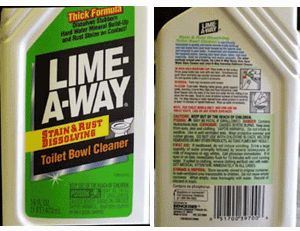There is no pre-lab quiz associated with this
experiment. Instead you are expected to complete the on-line TA evaluation
(in Owl). This evaluation is equivalent to one perfect pre-lab
quiz.
Introduction:
In terms of theory, this lab introduces nothing new. It does however review all aspects of stoichiometry to which you have been exposed and poses a problem that will test your stoichiometric skills and your ingenuity.
The other notable difference here is that whereas up to now we have given you a detailed procedure and provided you with a data table to fill in, this time it is up to you to design your own procedure and to present your results in an orderly fashion.
Household Chemicals:
It is always of interest to read the labels of household cleaners and
products, particularly to see the various primary chemicals associated
with each. Some of which you have met in the lab to date. To
list just a minor few:
| Chloride Ion: | Found in bleach and many of the dishwasher detergents. |
| Ammonia: | Found in household ammonia and smelling salts. |
| Sodium Hydroxide: | Found in some drain cleaners, oven cleaners and some bathroom cleaners. |
| Phenol: | Found in air-fresheners and furniture polish. |
| Hydrochloric Acid: | Found in the majority of drain and toilet bowl cleaners. |
| Formaldehyde: | Found in air-fresheners and mold and mildew cleaners. |
| Hypochlorite: | Toilet bowl cleaners and mold and mildew cleaners. |
 The above
is by no means a comprehensive list but rather a sampling. Next time
you start a cleaning job have a look at the label. There are all
sorts of warning on these labels concerning the use of these products and which combinations should not be used in tandem.
The above
is by no means a comprehensive list but rather a sampling. Next time
you start a cleaning job have a look at the label. There are all
sorts of warning on these labels concerning the use of these products and which combinations should not be used in tandem.
In this experiment the household chemical of interest is Lime-A-Way©, a toilet bowl cleaner whose primary ingredient is a strong (dissociates 100%) acid. The warning on this product is pretty explicit but nowhere does it give any indication as to the actual concentration of the acid involved. Your goal is to determine this.
Experimental Procedure:
General:
There isn't one! You are expected to come up with your own and give a written description of it to your TA. Remember, your TA will have little recollection of what you did in this experiment and if you do not provide a detailed description they will assume that you did only what is contained in your report. Use plenty of headings to differentiate the different aspects of the experiment that you did.
Your TA is looking for at least the following items addressed in the report.
-
A detailed method used to determine the molarity
of the original Lime-A-Way© solution.
-
A description on how you distinguished between the
two salts given.
-
Of course, balanced chemical equations where appropriate.
-
Details on all calculations made.
- Whether at least duplicate trials were performed in all critical areas.
Chemicals and Equipment:
I would not want to suggest that we are being a little sadistic with this experiment but there are a couple of wrinkles that you should think about prior to this lab. You are confined to the chemicals (some of which have had their labels mysteriously removed) and the equipment listed below.
Chemicals
- A dilute solution of Lime-A-Way©. (10mL of the original solution was diluted with distilled water to a final volume of 50mL)
- Two vials, one containing Na2CO3 the other CaCO3. Unfortunately there are no labels on the vials.
- An eye dropper.
- A 10mL graduated cylinder.
- The analytical balance.
- The beakers and Erlenmeyer's in your drawers can only be used as containment vessels.